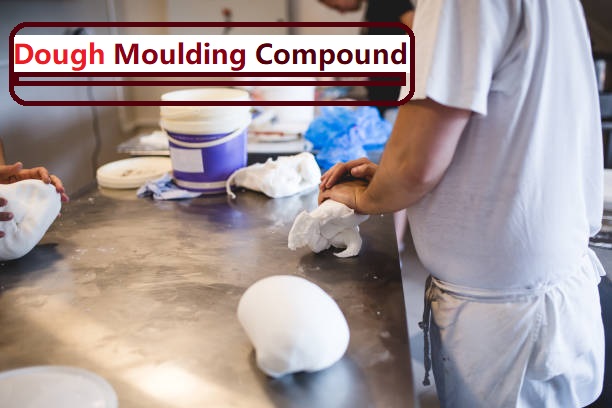What is Dough Moulding Compound?
Dough Moulding Compound, often abbreviated as DMC, is a ready-to-mold composite material made from unsaturated polyester resin, inert fillers, fiber reinforcements (typically glass fibers), catalysts, and other additives. The consistency of this material resembles putty or dough, giving it the name “Dough Moulding Compound.”
How Dough Moulding Compound is Made
Raw Materials Used in DMC
The main components of Dough Moulding Compound include:
- Unsaturated polyester resin
- Glass fibers for reinforcement
- Fillers such as calcium carbonate
- Catalysts for curing
- Thickeners like magnesium oxide
- Colorants and flame retardants (if required)
Manufacturing Process of DMC
The production process involves:
- Mixing all ingredients homogeneously
- Maturation of the dough to reach the desired consistency
- Cutting into appropriate sizes or preforms for molding
This meticulous process ensures consistency and reliability in the final product.
Properties of Dough Moulding Compound
Mechanical Strength
Dough Moulding Compound offers excellent mechanical properties such as impact resistance, dimensional stability, and tensile strength.
Thermal Stability
One of the key attributes of DMC is its thermal resistance. It can withstand high operating temperatures without deformation.
Electrical Insulation
Due to its high dielectric strength, Dough Moulding Compound is widely used in electrical applications.
Corrosion Resistance
DMC resists moisture, chemicals, and environmental degradation, making it ideal for outdoor and industrial uses.
Applications of Dough Moulding Compound

Automotive Industry
Dough Moulding Compound is used in manufacturing body panels, under-the-hood components, and interior parts due to its lightweight and durable nature.
Electrical Industry
DMC is commonly used in the production of switchgear components, circuit breakers, and insulators because of its superior insulating properties.
Construction Sector
It is used in construction elements like window frames, covers, and panels that require high strength and weather resistance.
Consumer Products
Dough Moulding Compound is also used in kitchen appliances, housings for electronic devices, and furniture components.
Advantages of Using Dough Moulding Compound
Design Flexibility
DMC allows for complex shapes and fine details, giving designers freedom in manufacturing.
Reduced Production Time
With high-speed molding processes, Dough Moulding Compound enables faster cycle times and efficient mass production.
Cost-Effective
Its raw materials are inexpensive, and the high production efficiency reduces overall costs.
High Performance
DMC components are known for their long service life, strength, and ability to endure challenging conditions.
Comparison with Sheet Moulding Compound (SMC)
While both are composite molding materials, DMC differs in texture and application:
- Texture: DMC is dough-like; SMC is sheet-form.
- Application: DMC is ideal for smaller, intricate parts; SMC suits larger components.
- Glass Fiber Content: DMC has shorter fibers, whereas SMC contains long, continuous fibers.
Why Industries Prefer Dough Moulding Compound

Consistency in Quality
Automated mixing and production result in uniform material properties across batches.
Ease of Handling
Its dough-like texture makes it easy to store, transport, and feed into molds.
Low Waste Generation
Most of the material can be molded with minimal trimming, reducing scrap rates.
Future Trends in Dough Moulding Compound Technology
Bio-Based Resins
There is increasing interest in using renewable sources for resin to make DMC more sustainable.
Advanced Reinforcements
Nanotechnology and hybrid fibers are being explored to enhance DMC’s performance further.
Automation Integration
Smart manufacturing and Industry 4.0 are set to optimize Dough Moulding Compound processing with minimal human intervention.
Best Practices for Molding Dough Moulding Compound
Preheating
Preheating the mold and compound improves flow and reduces voids.
Pressure Control
Optimal pressure ensures the DMC fills every mold cavity precisely.
Cooling Time Management
Controlled cooling prevents warping and ensures dimensional accuracy.
Challenges Associated with Dough Moulding Compound
Storage Sensitivity
DMC must be stored in cool, dry environments to maintain consistency.
Limited Shelf Life
Once compounded, DMC has a finite shelf life, after which it loses usability.
Environmental Impact
Though recyclable, improper disposal can affect the environment, making waste management essential.
Tips to Optimize DMC Usage
Invest in Mold Design
Well-designed molds reduce defects and enhance product quality.
Use Reliable Curing Agents
Proper curing is crucial for mechanical and thermal stability.
Regular Quality Checks
Frequent inspection ensures uniform properties and fewer production issues.
Recyclability and Environmental Impact
Dough Moulding Compound is partially recyclable. Regrinding scrap components and mixing with fresh compound reduces waste. However, advancements are needed in closed-loop recycling systems to make DMC fully circular.
Conclusion: Why Dough Moulding Compound Remains a Preferred Choice
Dough Moulding Compound is an indispensable composite material in today’s manufacturing ecosystem. Its balance of lightweight design, excellent mechanical properties, and electrical insulation makes it a go-to choice for various industries. From automotive to electrical, construction to consumer goods, the reach and versatility of Dough Moulding Compound are vast and ever-growing.
Its ability to be molded into complex shapes, along with fast production cycles and minimal waste, offer cost-effective and sustainable solutions. Although challenges like limited shelf life and environmental sensitivity exist, continuous innovation in materials and processes is addressing these hurdles.
As industries evolve toward more sustainable and performance-driven materials, Bulk moulding compound stands as a resilient, adaptable, and forward-compatible option. Manufacturers and designers alike can benefit from its unique properties, ensuring quality, durability, and aesthetic appeal in end products.
In an age where product innovation, cost-efficiency, and environmental responsibility are paramount, Dough Moulding Compound bridges the gap with proven effectiveness. As new technologies and bio-based enhancements emerge, its relevance and application are set to expand even further. Choosing Dough Moulding Compound isn’t just a material decision—it’s a strategic move for long-term innovation and growth.
Frequently Asked Questions
What is the main use of Dough Moulding Compound?
It is primarily used in electrical and automotive components for its strength and insulation.
Is Dough Moulding Compound eco-friendly?
Partially. Some formulations are recyclable, and research is ongoing to improve sustainability.
How long can DMC be stored?
Typically a few months under cool, dry conditions; beyond that, performance may degrade.
What is the difference between SMC and DMC?
DMC is dough-like with shorter fibers; SMC is sheet-based with longer continuous fibers.
Can DMC be used in outdoor applications?
Yes, due to its corrosion and weather resistance, it is suitable for outdoor use.




